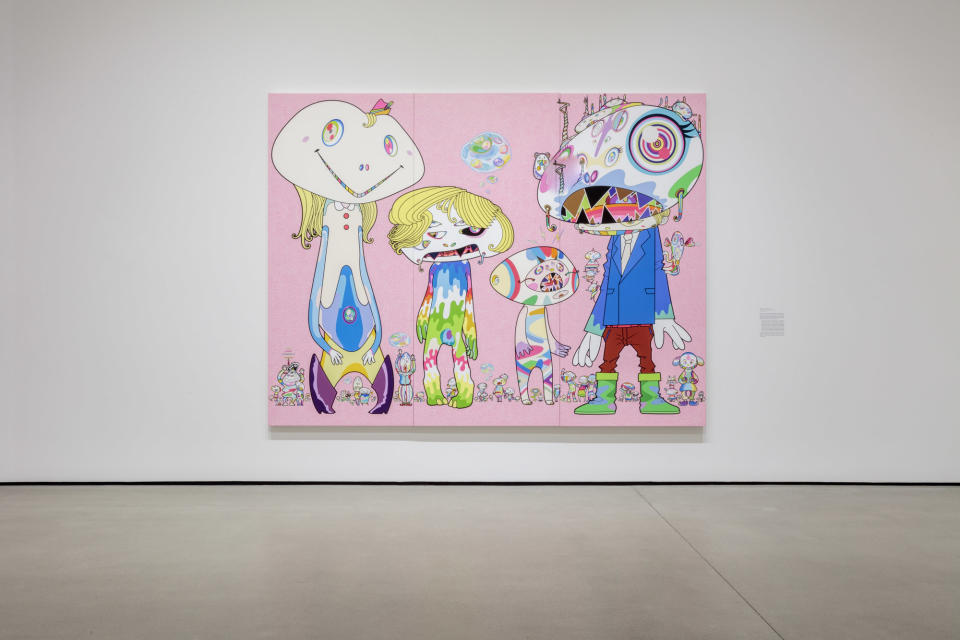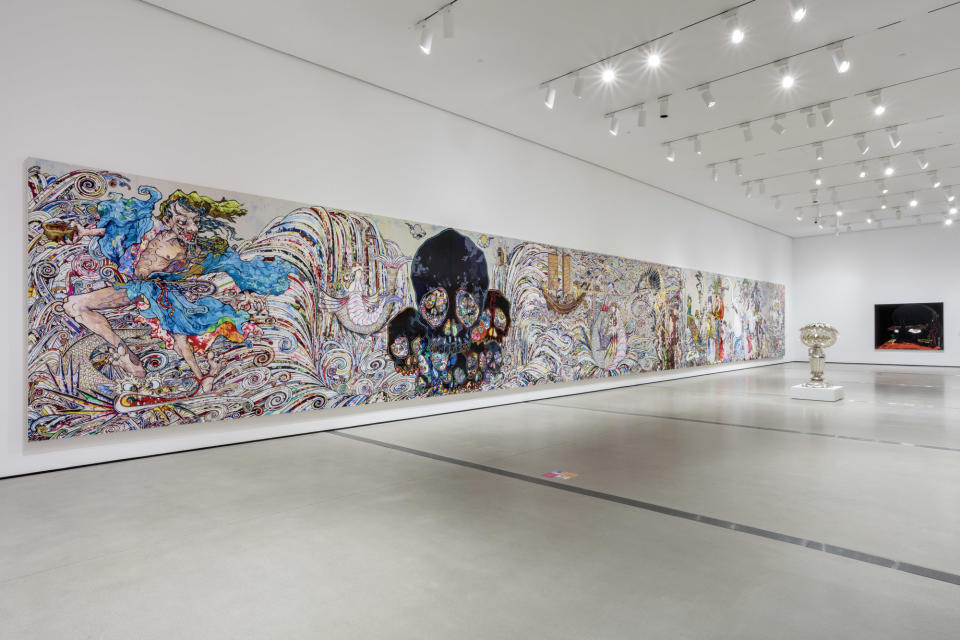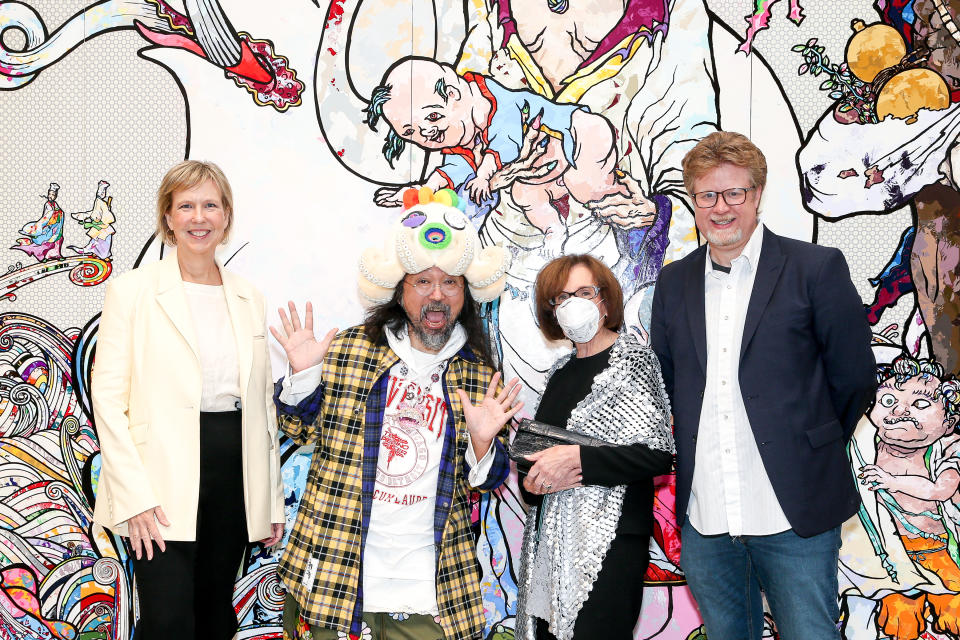Takashi Murakami on His New Art Show and AR Elements at L.A.’s Broad Museum

They look like their brains have melted. There are so many characters who like that in Takashi Murakami’s new exhibit, Takashi Murakami: Stepping on the Tail of a Rainbow, at the Broad Museum in downtown Los Angeles. Faces betray varying stages of alarm, brokenness, emptiness, despair, anxiety, bewilderment and even a frazzled, resigned serenity.
Take, for instance, his new 2022 painting, Unfamiliar People. The work, says the artist — during an interview in a garden area outside the museum — “looks like a space family from the 70s or maybe 60s” and has an “American animation” vibe to it.
More from The Hollywood Reporter
Britney Spears' Fiance Sam Asghari Opens Up About the Couple's Miscarriage, Hopes for Fatherhood
'Top Gun: Maverick' Pays Tribute to Late Director Tony Scott
But the impetus behind it was spending time on social media during the pandemic and Murakami’s shock at discovering the unexpected things it brought out in people.
As the artist’s wall label for the work explains, “Between normal times and times of emergency, people drastically change, and everyone started to look like aliens to me … On social media, for instance, someone who used to seem like a kind naturalist type unexpectedly started an aggressive protest against vaccines, denying their efficacy and claiming that the government was lying. I felt scared of people. I sensed that in times of emergency, everything about people could change, and wanted to give a form to this feeling.”
The famed 60-year-old artist elaborates, “It was really influenced by COVID. For the past two years, everyone was cooped up at home. A lot of the things that they couldn’t express that were really suppressed inside started to explode.”

Joshua White/Courtesy of The Broad
“And that’s when I started to see different sides of people that I didn’t know about them. It was almost akin to Kafka’s Metamorphosis,” continues the Japan-based artist, who is known for his high-low approach to art, collaborations with brands like Louis Vuitton, and themes of grief and tragedy often dressed up with poppy flowers and mushrooms (a reference to the atomic bombings of Japan during WWII).
The Broad exhibit — the artist’s first solo show there — features 12 pieces in the museum’s collection, including Murakami’s 82-foot-wide work In the Land of the Dead, Stepping on the Tail of a Rainbow (which was created as a response to the devastating Japanese earthquake and tsunami of 2011), as well as sculptures and wallpaper works. The exhibition also incorporates augmented reality elements throughout the space with QR codes that allow visitors to bring Murakami elements, such as his happy flowers, to life via cell phones. (The AR features were created with Instagram, design studio Buck, Meta’s Spark AR and the Broad.) The show runs through Sept. 25.

Joshua White/Courtesy of The Broad
Murakami — who also has a show up in New York City at Gagosian Gallery through June 25 — spoke further with THR about the decision to add AR elements to the Broad exhibit, why he doesn’t want to get back to his hectic pre-pandemic travel schedule and how his work is being influenced by the time his son played video games for 20 hours straight.
Why did you decide to add AR elements to this exhibit?
In the past, for museum shows, I would do wallpaper or projections onto the wall or add some component in addition to the actual presentation of works and then for this show, at first, I was thinking about projecting things onto the wall outside, but then the museum was really concerned about drivers getting distracted and causing traffic accidents.
Then the [idea of] AR technology came up, and I took note of it. I knew [creative director] Kristen [Joy Watts] from Instagram from way back, so I reached out to her to see if we could do something, and this came together.
Are you back to a normal schedule as far as traveling?
Yes, but I don’t want to go back to that schedule. The two years of the pandemic were stressful — about how to keep distance. But the other thing is that I am a geek, and sitting in my studio and using a pencil or something like that is very comfortable. I really want to step back to my studio.
You’ve been prominently engaged with creating NFTs. Do you believe they have a long-term future?
I’m more involved in the business structure [of NFTs], not just the art. The concept is very important — decentralized authority and giving independent freedom for the creator. That’s what I’m trying to pursue. That’s what I think will have longevity.
What has influenced you lately from the world of entertainment?
A lot, but these two years, the influence came from the game industry. I’m not playing, but my son and daughter are playing games, mostly Fortnite and Animal Crossing. This is super mysterious for me. For example, my boy played Fortnite for over 20 hours one day — he looked like crazy, and his eyes looked like a junky’s. And then [he said] ‘I don’t want to go to school. I want to play whole days.’ Finally, my wife stopped this game. It looks like a super-strong addiction. I want to access this mentality.
Can you talk about some of the influences in the older works on display, such as your monumental painting, In the Land of the Dead, Stepping on the Tail of a Rainbow, which you look at through the legend of the Daoist immortals of Chinese mythology?
The [Daoist immortals and] the great earthquake in Japan and the tsunami of 2011 were something that I really wanted to explore, including the mechanism of how religion originates. That was something I was learning and interpreting. And I’ve always felt that cultures arise in one place but then as they are transferred to and carried on to other regions and other cultures, they are always misinterpreted, and there are misunderstandings, and they keep changing. So this work is sort of epitomizing that process because the original motif [of the Daoist immortals] and the original paintings are from China, and Soga Shōhaku was a Japanese painter who sort of imported it and made it into his own work, but at that time already it was sort of deconstructed into his own interpretation. And then I again am taking that and reinterpreting and changing it from the original. So what I’ve done is a complete mess compared to the original, but I think this is really the essence of culture and cultural transmissions.

Jojo Korsh / BFA.com, courtesy of The Broad

